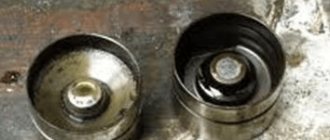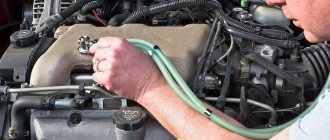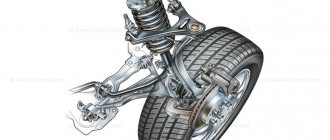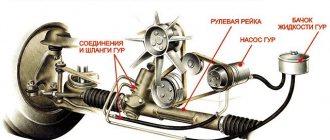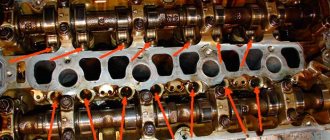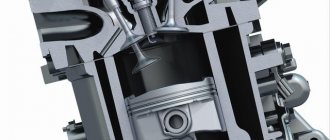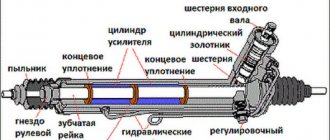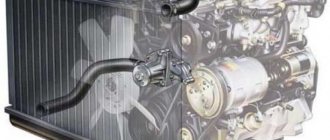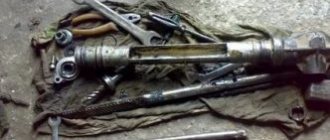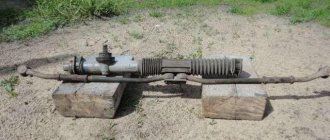Today we will talk about the causes of knocking in a car engine, how dangerous this phenomenon is, what to do in a given situation depending on its complexity, and how to diagnose a malfunction.
Quiet, measured noise of operation without extraneous sounds of the car’s power plant pleases every car owner, because this indicates the complete serviceability of the engine.
But the appearance of extraneous sounds during operation, in particular knocking, makes the driver worry.
There are more than enough reasons for knocking in engines, some of them only indicate the need for maintenance, but there are knocks that are a signal of major problems with the engine.
Causes of engine knocking
The knock itself is formed when one element of the power plant hits another.
At the same time, knocking in the engine varies; it can occur under certain conditions and disappear when they change.
In most cases, knocking sounds are a signal of problems with certain mechanisms - timing, crank mechanism, cylinder-piston group.
Although it may appear in other components of the unit.
Criteria for the nature of the knock.
Third-party sounds arising in the power plant can be divided into several criteria:
- The power of sound;
- Cause-and-effect relationships;
- Sound (metallic knocking, etc.);
- Cyclicality.
Let's look at each of the criteria.
So, in terms of sound intensity, a knock in the engine can be very weak and barely audible; in this case, the car can continue to be used, but it still wouldn’t hurt to carry out diagnostic work.
There is a knock of medium strength. It can be heard clearly, but it can be drowned out, for example, by playing music loudly.
A car with such knocking noises can be used for a short period of time, enough to be able to get to a garage or service center.
Distinct loud sounds coming from inside the power unit indicate significant problems in its operation.
With such sounds, the engine is turned off and the car is delivered to the garage or service only by a tow truck or in tow, since serious problems may arise with the engine.
Cause-and-effect relationships in the occurrence of knocking occur after non-professionals intervene in the power unit.
That is, doing the opposite - not carrying out technical work or repairs - can result in the occurrence of such a nuisance.
So, the cause of knocking in the engine can be:
- Oil that is not recommended for use on this engine or counterfeit oil.
- Poor quality or defective parts that were installed during repairs can also cause knocking in the engine.
- Severe wear of the components will naturally lead to the appearance of extraneous noise.
Types of sound and how they differ.
Based on the sound, engine knocking is divided into loud and dull.
A loud knock, also called metallic, occurs when parts made of hard metals collide with each other, and there is no oil layer between the parts.
A dull knock in the engine occurs when parts strike, one of which is made of soft metal, and there is an oil layer between the parts.
Cyclicality.
By the cyclical nature of the knocks, you can roughly determine which mechanism requires intervention.
Thus, knocking in the engine occurs in proportion to the rotation of the crankshaft, indicating possible problems with the cylinder-piston group, gas distribution or crank mechanisms.
The cause of a spontaneous knock that occurs haphazardly may lie in the engine attachment.
For example, a knocking sound may be made by a loose generator, and the sound will occur due to vibration of the power unit.
valves
The most common knocking noise observed at idle speed is valve tapping. At the same time, the sound is practically not observed at high speeds. Which happens due to the higher noise level produced by the engine. The problem, in this case, lies in incorrect valve adjustment. There is no need to delay eliminating the cause. Increased clearance leads to increased wear of the gas distribution mechanism.
Depending on the characteristics of the engine, adjustment can occur either by tightening the rockers or by replacing the washers. On “nines”, a knock may indicate wear on the cylinder head cups. This does not affect driving performance, but it is impossible to fix the problem. This is due precisely to tightening the valve adjustments.
Trick knockers
In addition, there is such a thing as “deceiver” knocks.
The essence of this concept is that a knock that seems to accurately indicate a certain malfunction has a completely different nature.
For example, when a diesel engine creates a load, a loud knocking sound appears, signaling problems with the crank mechanism. But the same knocking noise occurs with this engine when there is a malfunction in the power system.
Or, over time, a loose crankshaft pulley will begin to make sounds very similar to the knocking of the crankshaft itself, so it is important to first determine what exactly caused the appearance of extraneous sounds.
In any case, the occurrence of extraneous noise should not be ignored and professional diagnostics cannot be avoided.
How to fix the situation?
First you need to determine the cause of the knocking. The situation can be corrected by replacing the non-functioning element, since it is impossible to disassemble the shock absorber. By the way, replacement should only be done in pairs. That is, if you changed the shock-absorbing device on the left side, change it on the right as well.
Some car enthusiasts still try to make minor repairs to a defective item. To do this, they cut off the rolling of the body. After cutting, you can remove the piston with rod. This allows you to check the rod and pistons and, if necessary, replace them - and also add new working fluid. During assembly of the mechanism, the cut rolling area will have to be welded. This is a complex process - it is much easier to buy new elements and install them.
To prevent knocking, it can be recommended to avoid “forcible” operation of the car. It is clear that the roads need to be chosen more evenly - it’s hardly worth talking about
Pay special attention to the condition of the oil. In cold weather, you should not pick up speed too quickly, because at the very beginning of movement the temperature of the working fluid corresponds to the air temperature
Excessive oil viscosity is a common cause of valve disc failure. To avoid this, it is better to pick up speed a few minutes after the start.
The service life of shock-absorbing elements is limited. But to prevent them from breaking prematurely, you must follow the rules for operating the car.
1200 rub. for the photo report
We pay for photo reports on car repairs. Earnings from 10,000 rubles/month.
Write:
Knocking in the suspension sooner or later occurs on any car. There can be many reasons for its occurrence - problems with the chassis, improper operation of the machine, a frivolous attitude to prevention, and so on. How to identify the cause of the breakdown and what to do in this case?
Extraneous sounds when idling
Let's look at the causes of knocking in the engine under different operating modes.
First, let's look at the reasons for its occurrence at idle.
Here you first need to determine the behavior of the knock in the future.
Thus, a slight knocking sound in the engine at idle, emanating from the middle part of the engine, having a uniform intensity, while the sound intensity decreases somewhat with increasing speed, may indicate small third-party parts or debris from parts entering the cylinder.
This problem is eliminated by removing the block head and removing foreign objects.
The same knock, but increasing with increasing speed, can signal significant wear of the cylinder-piston group, damage to the piston skirts due to overheating.
This malfunction can only be eliminated by replacing the cylinder-piston group.
The appearance of a similar noise, but with half the intensity, and heard in the upper part of the unit, may indicate a malfunction of the timing belt.
If a knock is present not only in idle, but also in other modes, this may indicate wear on the camshaft or a violation of valve adjustment.
If the thermal gap is adjusted using hydraulic compensators, the knocking noise may decrease as the speed increases.
But this indicates a malfunction of the hydraulic compensators.
Problems with the cylinder head are solved by removing the valve covers, determining the source of the sound, replacing worn elements or adjusting the clearance.
A uniform knocking noise, which increases significantly with increasing speed, if it comes from below, may indicate destruction of the balancer shaft bearings, the beginning of destruction of the connecting rod liner, or deformation of the connecting rod itself.
These are some of the most dangerous causes of noise.
If at idle you hear an uneven sound that completely disappears as the speed increases, this is a signal of problems with the bearings of the engine attachments, for example, a malfunction of the pump bearing.
A muffled, uneven knock that appears at idle and disappears as the speed increases may indicate that the permissible oil level has been exceeded due to working fluids or fuel getting into it.
In this case, an internal breakdown of the cylinder head gasket occurred and antifreeze began to flow into the oil.
All of the above malfunctions, except for destruction of the connecting rod bearings and balance shafts, are generally not very dangerous; the driver has the opportunity to deliver the car under its own power to a service center or garage.
Faults that increase engine noise
When unnatural sounds appear in a running engine, the driver tries to understand their cause and, when he comes to a certain conclusion, seeks to fix the problem on his own or involve his friends who have the necessary experience.
The most significant malfunctions that cause unusual noise in a running engine:
- Use of low quality oils and fuel;
- Malfunctions of the lubrication system;
- Inappropriate temperature conditions;
- Problems with the ignition system;
- Worn timing belt;
- Malfunction of hydraulic compensators;
- Problems in the timing belt;
- Unstable operation of the idle speed controller;
- Malfunction of electrical systems.
So many malfunctions that are caused by extraneous or more powerful noises from the power unit can only be sorted out by a car service specialist, and that is where you should go.
Delay in this case will result in serious damage and the need for an expensive overhaul of the engine,
Engine knocking when cold
Engine knocking when cold also has several causes. Thus, an uneven sharp knocking sound when cold, increasing as it warms up, may indicate:
- Turning of the connecting rod bearing around the axis or its destruction;
- Significant wear of the main liners, deformation of the crankshaft journals. In this case, the sound comes from the bottom of the motor;
- A sound may occur in the middle part of the engine if there is significant wear on the mounting holes of the piston pins; it usually appears with a sharp increase in engine speed.
Many of the reasons described are also characteristic of the engine operating conditions described below.
Knock at low speeds
A knocking sound in the engine at low speeds when the engine is not warmed up, if it comes from the top, indicates problems with the hydraulic compensators.
A uniform knocking sound in the upper part, which increases significantly when warming up, can signal the beginning of destruction of the valve seat.
It is worth considering the possibility of damage to the bearings of attachments.
It is also possible that the valve timing is disrupted due to the timing belt slipping, as a result of which the piston bottoms come into contact with the valves, hence the knocking sound in the engine.
Refueling with low-octane gasoline can cause a phenomenon called detonation, which is what causes knocking.
If you detect extraneous noise while the engine is running cold at low speeds, it is better to immediately try to determine where exactly the noise is coming from.
If the knocking sound in the engine comes from the top, the car can still be driven for a short time.
If sharp noises appear from the lower part of the engine, it is better to immediately stop the power plant and deliver the car to the repair site by tow truck or in tow.
Third-party sounds on startup
Engine knocking during startup most often occurs due to malfunctions in the lubrication system.
Poor performance of the oil pump, insufficient amount of oil and clogging of the channels with pollutants leads to the fact that the oil does not have time to reach all the rubbing surfaces in time, which is why grinding and knocking noises are heard.
Due to problems with the lubrication system, oil does not flow into the hydraulic compensators, without which they begin to knock.
If noises appear during startup, it is advisable to stop the engine and check the oil level. If necessary, bring the level to the desired value.
If this does not help, you can change the oil and pre-flush the system.
Next, if the knocking noise persists during startup, you need to check the condition of the oil pump.
Common Sound Sources
Most malfunctions in cars first manifest themselves in the form of third-party sounds.
- A violation of the timing valve clearance is manifested by a metallic knock from under the hood.
- A worn alternator belt often begins to “squeal.”
- Wear of rubber suspension elements is accompanied by knocking noise from the wheels, and worn shock absorbers are accompanied by strong knocking noises when driving over uneven surfaces.
- The brake system may have calipers or pads knocking, and even a flat tire hitting the hub when moving creates a characteristic sound.
Causes of sounds when hot
Knocking in the engine when “hot” can occur for all of the above reasons.
In any case, it is important to determine the nature of the sound, the approximate place where it is coming from, and then take action.
Almost always, in road conditions, it will not be possible to eliminate the malfunction; the car will need to be delivered to the repair site to accurately determine the cause.
But preliminary diagnostics will tell you which way the car will have to be delivered.
If there is a knocking sound at the top, you can drive the car under your own power, but check the oil level before doing so.
A sharp sound from the bottom of the engine will indicate a problem with the crank mechanism, which is why the car must be delivered by a tow truck.
Peculiarities
These sounds can have a very different character. They can be heard from different sides of the car, and also occur in a certain position of the pedal. The knock can be either single or repeated. Most often, a knocking noise is heard from the front when braking after any maintenance work has been done on the brake system. It is very difficult to diagnose problems in brake mechanisms by knocking. Even if something vibrates, it is not at all necessary that it will be the brake system. Sounds can come from leaking struts and failed rear shock absorbers, anti-roll bar fasteners and many other components.
Features of knocking in the engines of VAZ cars
The described reasons for the occurrence of third-party sounds are typical for all engines, including VAZ models.
In addition to the above reasons, in classic models, knocking in VAZ engines can be caused by a strong stretch of the timing chain or a weakening of the chain tensioner.
And for models starting from the VAZ 2108, additional increased noise may occur due to wear of the belt tensioner bearing.
Diesel engines, additional possible sources of knocking.
If a diesel engine knocks, in addition to problems with the crank mechanism, cylinder-piston group and timing, the knock can be caused by problems with the power system, in particular, malfunctions with the injection pump, turbine or injectors.
Or a violation of the timing of fuel injection.
Causes related to drive and suspension
Now let's move on to other elements of the car in which knocking may occur when turning the steering wheel. There are not many of them, but malfunctions with them can lead to expensive repairs
If you hear a knocking sound with a crunching effect when the wheel is turned completely, this often indicates severe wear of the constant velocity joint (CV joint) used in the wheel drive mechanism.
The CV joint itself is a fairly reliable element if it is protected from dust and dirt getting inside. Read on the topic - replacing the inner CV joint boot of popular car models.
Therefore, it is quite easy to determine that this is the cause of the knocking when turning - you need to carefully inspect the protective boot.
If it is damaged, we can say with complete confidence that the cause of the third-party crunch is the CV joint.
Many car enthusiasts claim that it is possible to fully restore the performance of the CV joint by removing it, washing it and adding new lubricant.
Some additionally add small shavings of soft plastic to the lubricant, for example, from a cork from a Champagne bottle. Be sure to replace the damaged boot.
However, such measures can only delay the replacement of the hinge for a while and in the end it will still have to be replaced. And when to perform this operation - immediately upon detection of damage to the boot, or a little later - it is up to the car enthusiast to decide.
In many modern domestic cars, the weak point is the shock absorber strut bearing. It can also cause knocking.
This problem seems to be easily solved - it is enough to replace the support, but sometimes this is not very easy to do. After all, you will have to remove the entire rack from the car.
Also, a broken strut spring may be knocking in the suspension. At the same time, it will no longer be able to fully perform its functions, which will lead to rapid failure of the shock absorber.
Therefore, if noise appears, you should immediately inspect the spring. If it bursts, you will have to change it, and it is changed in pairs on both sides of the car.
If you hear a knocking sound on your car when turning, but it is also accompanied by a hum, it is likely that all this is due to wear on the wheel bearing.
It is quite easy to diagnose his condition.
You need to jack up the wheel on the side where the knock is coming from and rock it, checking for axial play.
If such play exists, the bearing needs to be replaced, which is impossible to do without the appropriate equipment and knowledge.
Diagnosis of knocking in the front suspension on small bumps
Diagnosis of the cause of the sound
If a problem arises that the engine is knocking, as already said, it is first of all important to determine the nature of the knock, as well as the location of its occurrence.
Some of the reasons can be diagnosed without disassembling the power plant.
Thus, a special device - a technical phonendoscope - will allow you to more accurately determine the location of the noise.
Using it, the engine is listened to and it is determined in which mechanism or system malfunctions have occurred.
You can also use more advanced equipment, for example, a motor tester.
A simple procedure will allow you to determine the destruction of the connecting rod liner.
It is done like this: with the engine running, when a loud knocking noise appears, the high voltage wire is removed from the spark plug one by one on each cylinder.
If the fault lies in the connecting rod bearing, then disconnecting the wire on the cylinder that has the problem will significantly reduce the knocking noise.
If noise occurs, when there is a suspicion of destruction of the bearing of any attachment, you can determine which equipment has problems by disconnecting their drive from the on-board network.
If after this the sound disappears, the faulty equipment is replaced or sent for repair.
Knocks at the top of the engine.
They are diagnosed sequentially. First, the condition of the cylinder head elements and their fastening is checked.
Then the valves are adjusted or the hydraulic compensators are washed. At the same time, the level and condition of the oil are checked.
Then the head is removed from the engine and a full range of restoration work is carried out.
Middle and lower part of the engine.
An accurate determination of the cause of knocking in the lower part of the engine is possible only after disassembling the engine.
Since severe wear of the cylinder-piston group also causes unwanted sound, therefore, if a knock occurs in the middle part, the condition of this group can be assessed by measuring compression.
If the knock is caused by detonation, its presence can be determined by the behavior of the power plant.
If it continues to work for some time after a forced stop, there is detonation in the cylinders.
Diesel power plants.
Diagnostics in these engines is carried out identically to those described, but their fuel system can be diagnosed only after removing its elements and only on special stands.
Brake systems
This is one of the key safety factors. It is with the help of brakes that the driver can reduce the speed of the car until it comes to a complete stop. There are several types of systems. The most common option is with a hydraulic drive. Here, the force from pressing the pedal is transmitted using brake fluid to the actuators. They are on the hubs. As for the brake mechanisms themselves, two types of solutions are used in cars. These are the popular disc brakes today and the older version - drum brakes. In the first mechanisms, the pads interact with a disc mounted on the hub. As for the second, they are located inside the brake drum. The deceleration process is carried out due to the fact that the pads are unclenched and pressed against the internal planes of the drum.
Drum brakes are a rather old and archaic solution. But they are still widely used on budget cars. A parking brake is also implemented using drum brakes. Thus, there are disk systems in front, and drum systems in the back.
